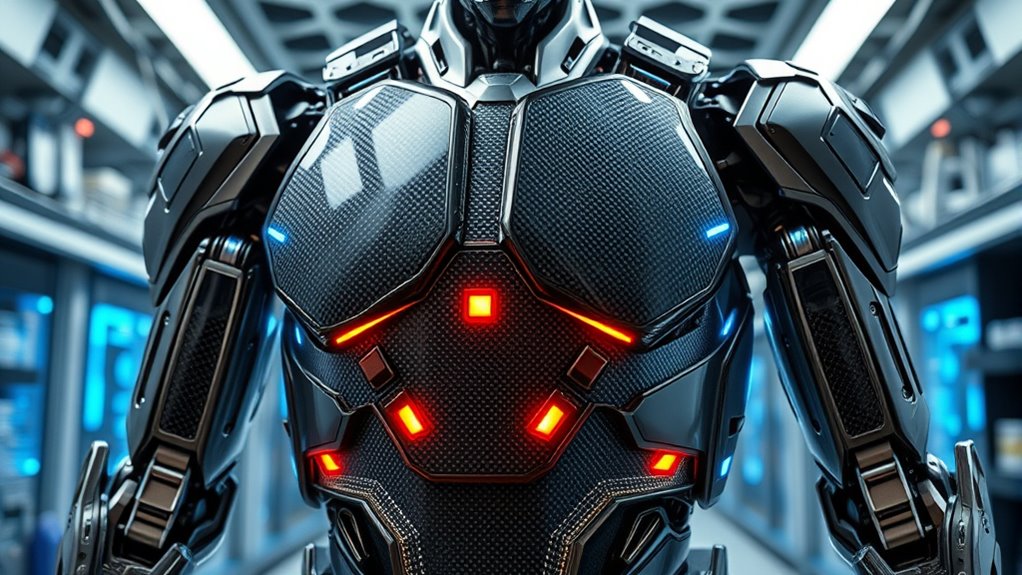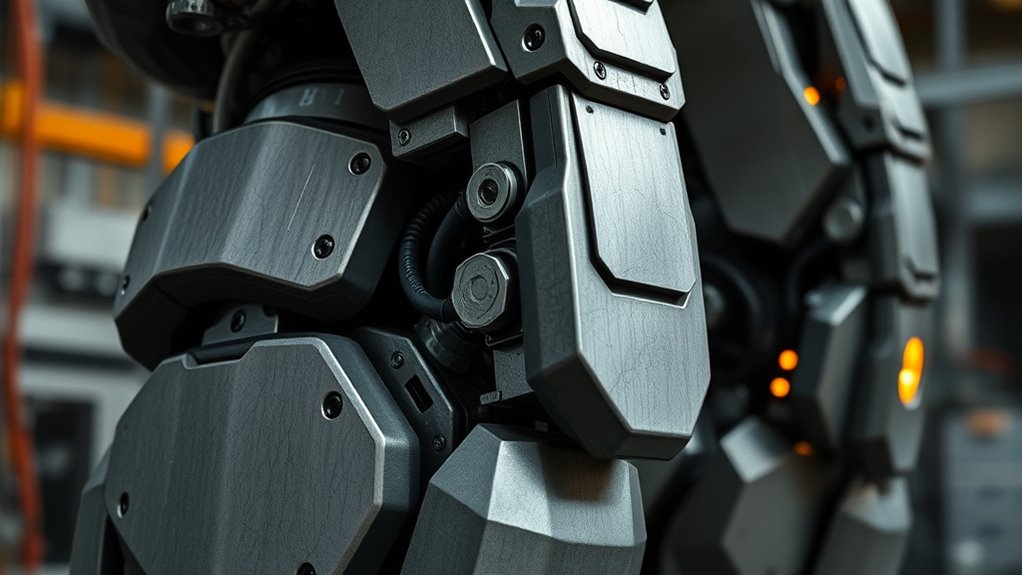To build durable doomsday robots, choose lightweight yet high-strength alloys like 7075 aluminum or corrosion-resistant metals such as stainless steel and nickel-based alloys. Incorporate advanced composites like carbon fiber reinforced polymers for impact resistance and durability. Use impact- and wear-resistant plastics like polycarbonate and PEEK for critical parts, and select materials suited for extreme temperatures, like polyimide. Combining these options guarantees resilience; keep exploring to discover the best material strategies for extreme conditions.
Key Takeaways
- Use lightweight, high-strength aluminum alloys like 7075 for durability and ease of movement.
- Incorporate advanced composites such as carbon fiber reinforced polymers for corrosion resistance and structural resilience.
- Select impact-resistant plastics (e.g., polycarbonate, UHMW) and wear-resistant metals (e.g., AR steels) for shock absorption and longevity.
- Integrate high-temperature polymers like PEEK and polyimide to withstand extreme thermal stresses.
- Combine diverse materials to optimize strength, environmental resistance, and energy management for maximum durability.
Lightweight and High-Strength Alloys for Structural Integrity

Lightweight and high-strength alloys are essential for guaranteeing the structural integrity of doomsday robots, especially when durability and mobility are critical. Aluminum alloys are prime choices due to their high strength-to-weight ratios, helping you keep the robot light without sacrificing strength. Their inherent corrosion resistance, thanks to a protective oxide layer, reduces maintenance and extends lifespan in harsh environments. With densities around 2.7 to 2.8 g/cm³ and tensile strengths up to 590 MPa, aluminum offers versatility for complex designs through die-casting. Innovations in alloy development boost strength-to-weight ratios further, making them more efficient and sustainable. By selecting alloys like 7075, you ensure your robot’s critical components are both durable and lightweight, optimizing performance under extreme conditions. Additionally, ongoing research into advanced alloys continues to push the boundaries of what lightweight materials can achieve in demanding applications. Moreover, understanding the material properties is crucial for selecting the most suitable alloy for specific operational requirements.
Advanced Composite Materials for Durability and Efficiency

Advanced composite materials play an essential role in enhancing the durability and efficiency of doomsday robots, especially in harsh environments. Their superior corrosion resistance protects against moisture and chemicals, ensuring long-term stability. These materials maintain their structural integrity under extreme temperatures and resist water absorption, reducing maintenance needs and extending service life.
With a high strength-to-weight ratio, composites like carbon fiber reinforced polymers provide exceptional strength without added weight, boosting mobility and performance. Their high stiffness and impact resistance make them ideal for withstanding shocks and stresses.
Additionally, composites are highly versatile, used across aerospace, automotive, marine, and construction industries. Their flexible processing and customizable layered designs allow engineers to optimize performance, making advanced composites crucial for creating resilient, efficient doomsday robots.
Corrosion-Resistant Metals for Harsh Environments

Corrosion-resistant metals are essential for building doomsday robots that must operate reliably in harsh environments. Stainless steel offers exceptional durability and high resistance to corrosion thanks to its chromium content, making it ideal for demanding conditions. Creativity in material selection plays a crucial role in developing innovative solutions for extreme environments.
Corrosion-resistant metals ensure doomsday robots operate reliably in harsh environments.
Copper-based alloys resist corrosion in air, water, and chemicals while providing excellent thermal and electrical conductivity, useful in marine and industrial settings. Their versatility makes them a popular choice for various applications where corrosion resistance is critical.
Nickel-based alloys withstand extreme temperatures and corrosive substances, ensuring long-lasting performance in challenging environments. Their ability to maintain structural integrity under stress is vital for mission-critical operations.
Aluminum, lightweight and corrosion-resistant, is perfect for aerospace and marine applications, thanks to its self-repairing oxide layer. This property allows it to recover from minor damages, extending its usability in critical applications. Additionally, advancements in corrosion resistance technologies continue to improve its durability further.
These metals not only prolong the lifespan of your robot but also reduce maintenance needs. Selecting the right corrosion-resistant material ensures your doomsday robot remains functional and resilient, even amid the toughest environmental factors. Understanding corrosion resistance is crucial for maintaining the integrity of materials in extreme conditions.
Polymer Composites for Tailored Mechanical Properties

Polymer composites are engineered materials whose mechanical properties can be precisely tailored to meet specific application requirements. By adjusting their composition and microstructure, you can optimize properties like tensile strength, stiffness, and impact resistance.
Incorporating reinforcing fibers boosts these characteristics, making them suitable for demanding environments. Processing techniques such as resin infusion and curing directly influence the composite’s quality and performance. Fiber orientation is a critical factor that affects the anisotropic behavior of the composite, allowing for directional strength customization.
Customization is achieved through fiber orientation and matrix formulation, allowing you to design materials that meet precise mechanical needs. Environmental factors like moisture and temperature can affect their behavior, so understanding these influences helps in selecting the right composite. Additionally, awareness of brand reputation can guide you toward reliable sources for high-quality composites.
Understanding Narcissistic Behavior is essential for recognizing potential emotional vulnerabilities that might influence how these materials perform under stress or manipulation, especially in high-stakes applications.
Impact-Resistant and Wear-Resistant Materials

Impact- and wear-resistant materials are vital for building durable doomsday robots that can withstand harsh conditions and repeated impacts. Impact-resistant plastics like ABS and polycarbonate provide toughness and high impact strength, ideal for structural components.
PPSU is autoclavable and resilient, while UHMW offers exceptional impact resistance. PETG combines impact toughness with excellent thermoforming capabilities.
On the metal side, Tensalloy and AR series steels deliver high impact and wear resistance, with AR500 steel suited for harsh impacts.
Wear-resistant plastics such as Torlon and PEEK excel in high-stress environments, offering outstanding impact and wear properties.
Minerals like silicon carbide and alumina provide exceptional hardness and durability for abrasive scenarios.
Combining these materials guarantees your doomsday robot maintains integrity under extreme impacts and prolonged wear, vital for survival in hostile environments.
Material Selection for Extreme Temperature Resistance

Selecting the right materials for extreme temperature resistance is essential when designing doomsday robots that must operate reliably in harsh environments. Metal options like tantalum carbide (TaC) and hafnium carbide (HfC) stand out because of their incredibly high melting points—around 3768°C and 3958°C, respectively. Refractory metals such as tungsten, molybdenum, and rhenium also withstand extreme heat. Ceramic materials like carbon-carbon composites and ceramic-based aerogels provide excellent thermal insulation, maintaining strength at high temperatures and reducing heat transfer. High-performance materials are crucial for ensuring durability and safety in extreme conditions. Incorporating advanced thermal protection systems can further enhance a robot’s ability to withstand temperature fluctuations. Polymers like polyimide and PEEK can endure elevated temperatures for specific components. Combining these materials allows you to create a resilient system capable of withstanding extreme thermal stresses, ensuring your doomsday robot functions effectively in the most demanding environments.
Combining Materials for Optimal Durability

Combining different materials is key to achieving peak durability in doomsday robots, especially when facing extreme conditions. By integrating materials like carbon fiber composites with fiber reinforced polymers, you can create lightweight structures with exceptional strength and flexibility. Material science advancements continue to drive innovation in creating more resilient and adaptable robotic systems. Additionally, advances in composite material technology enable the development of multifunctional components that can meet diverse operational demands. Incorporating vibrational energy management techniques can further enhance the robot’s ability to withstand shocks and vibrations during operation, ensuring longevity and reliability in harsh environments. Implementing sustainable material practices aligns with responsible design principles and supports environmental sustainability goals.
Frequently Asked Questions
What Are the Best Materials for Electromagnetic Shielding in Doomsday Robots?
When choosing materials for electromagnetic shielding in doomsday robots, consider copper for its superior conductivity and effectiveness against EMI, despite higher costs.
Mu-metal offers excellent magnetic shielding and flexibility, ideal for sensitive components.
Beryllium copper provides broad-frequency shielding with high strength.
Stainless steel, while less conductive, adds durability and corrosion resistance.
Combining these materials, you can optimize protection, ensuring your robot withstands harsh environments and electromagnetic interference.
How Do Materials Affect the Robot’s Energy Efficiency and Battery Life?
Materials play a vital role in your robot’s energy efficiency and battery life. Lightweight materials reduce energy needed for movement, while shape memory and supercapacitors help conserve power. High-conductivity materials like graphene improve energy storage, and thermal management helps keep batteries healthy. By choosing the right materials, you can optimize your robot’s performance, extend battery life, and guarantee it operates efficiently in demanding environments.
Which Materials Are Best Suited for Underwater or Aquatic Environments?
When choosing materials for underwater environments, you need to focus on corrosion resistance, weight, and strength. Plastics are great because they’re lightweight and resist corrosion.
Titanium offers high strength, is lightweight, and withstands deep-sea pressure.
Syntactic foams provide buoyancy, helping your vehicle stay balanced.
Anodized aluminum can work for shallow depths, but for harsh conditions, titanium and specialized alloys are your best bets for durability and performance.
How Can Materials Be Optimized for Stealth and Camouflage?
You seek to optimize materials for stealth and camouflage, balancing invisibility with resilience. While your focus might be on visual concealment, don’t overlook acoustic and electromagnetic properties that enhance stealth.
By integrating adaptive materials that shift reflectivity, thermal paints that mask signatures, and sound-absorbing coatings, you create a multi-layered defense.
Combining these techniques guarantees your robot remains undetectable across various sensing methods, maximizing its stealth capabilities in diverse environments.
What Are the Environmental Impacts of Using Advanced Durable Materials?
You should consider that using advanced durable materials impacts the environment in several ways. While recycled metals and bio-based polymers reduce waste and lower carbon footprints, their production can still cause pollution if not managed properly.
These materials help conserve resources, protect biodiversity, and support climate change mitigation. However, you need to balance their benefits with potential pollution from manufacturing processes, ensuring sustainable sourcing and responsible use.
Conclusion
Choosing the right materials is like assembling a superhero’s armor—you need strength, resilience, and adaptability. By combining lightweight alloys, advanced composites, and corrosion-resistant metals, you create a doomsday robot that’s built to withstand the apocalypse. Remember, the key to durability isn’t just one material, but how you blend them into a formidable fortress. With the right choices, your robot will stand tall as a steel titan in the storm of chaos.










